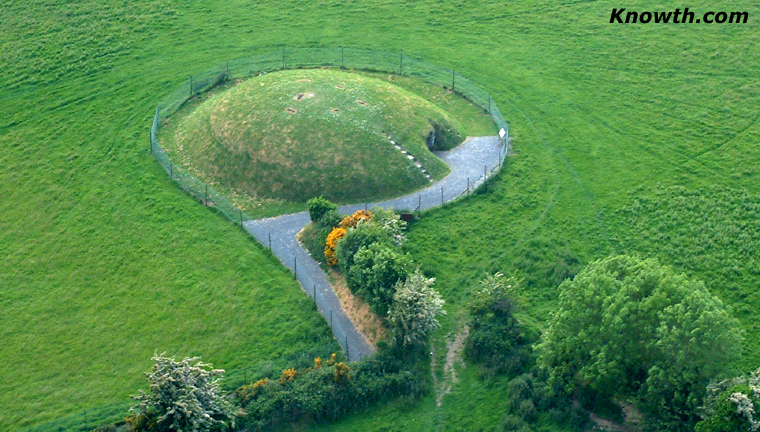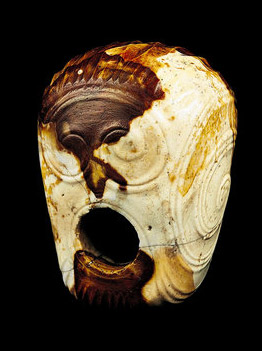The megalithic passage tomb called the Mound of the Hostages
(Duma na nGiall) is the oldest monument on the Hill of Tara dating back
to between 2500 B.C. and 3000 B.C. The passage, 4m in length and 1m wide,
was subdivided by sill stones into three compartments each containing cremated remains.
A wonderfully decorated stone can be viewed from the entrance gate. The engravings may represent the sun,
moon or stars as religious symbols or maybe the stone was used as a prehistoric calendar.
Drawing of decorated orthostat.
Click here to read more....
Sources:
The Knowth
Mythical Ireland
Megalithic Ireland
Sacred Destinations
Megalithic Complex
Carrowkeel
was one of the least known of Ireland's ancient sites until
recent years. It is the most spectacularly situated of all the great
megalithic complexes. The neolithic monuments are spread across the
highest summits and ledges on the north
ends of the Bricklieve Mountains
in south County Sligo. Carrowkeel is situated on the west side of Lough
Arrow,
overlooking the modern village of Castlebaldwin. It is easy to find, well
signposted from the main Dublin/Sligo (N4) road below.
This
whole area, a good chunk of County Sligo was one of the most important centres of neolithic Ireland. Carrowmore and Carrowkeel are joined by the Uinshin river which flows
from Lough Arrow to Ballisodare Bay, the main road through the thickly wooded region.
It is a landscape rich with physical remains of the ancient past, and
mythical echoes that can still be perceived in the majesty of the locations
and views from the top of the mountains across the plains of Sligo.
Sources:
Dowth the Fairy Mound of Darkness is about the same size as Newgrange and
Knowth and was built in
the same period over 5000
years ago. The mound was subjected to a very unprofessional excavation
in 1847, two passage tombs were discovered but the mound
was severely damaged in the process. The passages tombs are much less
spectacular than Newgrange or Knowth with shorter passages
and lower roofs. Both are on the western side of the mound, they are
referred to as Dowth North and Dowth
South. The Dowth North passage is 14 metres in length; the chamber is
cruciform in shape with an annex off the right hand recess,
the chamber roof is corbelled and is 3 metres high. Click to read more....
Sources:
The Knowth
Newgrange
Megalithic Ireland
Mythical Ireland
Voices from the Dawn
Ancient Ireland
World Heritage Ireland
Fourknocks is a Passage Chamber Tomb built about 5000 years ago. It is located
10 miles southeast of Newgrange between Ardcath in County
Meath and the Naul in County Dublin.
The
name Fourknocks may be from the Irish Fuair Cnocs meaning Cold Hills
or maybe Four Cnocs is a reference to the Four Tombs (Four
Hills). Only the main tomb pictured above has been excavated and is open to
the public. Click to read more....
Sources:
The Knowth
Meath.ie
Mega Lithic Ireland
Mythical Ireland
Ancient Ireland
Voices from the Dawn
The Cairns are megalithic structures originally built about 4000 bc
as burial chambers.
The Megalithic Cairns are dotted around the Slieve na Caillaigh hills at Loughcrew, the main
concentrations are on Carnbane East where Cairn T is the centrepiece and
Carnbane West where Cairn L is located.
The illumination of the passage and chamber at the Winter
solstice sunrise in Newgrange is world famous. Less well known is the
Equinox illumination at sunrise in Cairn T at Loughcrew. The backstone of the chamber is illuminated by
a beam of light at sunrise on the Spring and Autumnal Equinoxes.
The sun light is shaped by the stones of the entrance and passage and descends the backstone while moving
from left to the right illuminating the solar symbols.
Click to read more....
Sources:
The Knowth
Loughcrew Gardens
Meath.ie
Mega Lithic Ireland
Mythical Ireland
Carrowkeel
Voices from the Dawn
Newgrange was constructed over 5,000 years ago (about 3,200 B.C.), making it older than Stonehenge in England and the Great Pyramid of Giza in Egypt. Newgrange was built during the Neolithic or New Stone Age by a farming community that prospered on the rich lands of the Boyne Valley. Knowth and Dowth are similar mounds that together with Newgrange have been designated a World Heritage Site by UNESCO
Click to read more....
Sources:
The Knowth
Mythical Ireland
Newgrange Ireland
Meath.ie
World Heritage Ireland
Megalithic Ireland
Voices from the Dawn
This
ceremonial macehead, found beneath the eastern chamber tomb at the great
passage tomb at Knowth, in the Boyne Valley, is one of the finest works of art
to have survived from Neolithic Europe. The unknown artist took a piece of very
hard pale-grey flint, flecked with patches of brown, and carved each of its six
surfaces with diamond shapes and swirling spirals. At the front they seem to
form a human face, with the shaft hole as a gaping mouth.
If it was made in Ireland, the object suggests that someone on the island had
attained a very high degree of technical and artistic sophistication. Click to read more....
Antrim / Aontroim
Ulster – Established c. 1400, the name translates to “lone ridge” or “lone dwelling.”
Armagh / Ard Mhacha
Ulster – Established c. 1584, the name means “Macha’s height.” Macha was
a Celtic goddess said to have given birth to twins after racing a
horse.
Carlow / Ceatharlach
Leinster -- Established c. 1306, the name translates to “place of cattle.”
Cavan / An Cabhán
Ulster – Established in 1584, the name translates to “the hollow.”
Clare / An Clár
Munster -- Established in 1565, the name translates to “plain.” The
county may have been named after the Norman de Clare family. Before
1565, Clare was known as Thomond, which means “North Munster.”
Cork / Corcaigh
Munster – Established c. 1200, the name means “swamp” or "marsh." (But don’t tell anyone from Corcaigh.)
Derry / Doire
Ulster – Established in 1585, the name “Doire” means “oak wood.”
Donegal / Dún na nGall
Ulster – Established in 1584, it means “stronghold of the foreigners”
(Vikings). It was also known by some as Tir Chonaill, which means “the
land of Conall.”
Down / An Dún
Ulster – Established c. 1520, the name means “the fort.”
Dublin / Áth Cliath / Dubhlinn
Leinster -- Established in 1185, the “Áth Cliath” part means “hurdled fort” and the “Dubhlinn” part means black pool.”
Fermanagh / Fear Manach
Ulster -- Established in 1584, the name translates to “Men of Manach”
or, more specifically, “men from the county of the lakes.”
Galway / Gaillimh
Connacht – Established in 1565, the county was named after the river Gaillimh, which means “stony.”
Kerry / Ciarrai
Munster – Established c. 1200, the name translates to “People of Ciar.”
Break it down further, and you find that Ciar means “black” or “dark
brown” and Raighe means “tribe.”
Kildare / Cill Dara
Leinster – Established 1297, it means “church of the oak.”
Kilkenny / Cill Chainnigh
Leinster – Established c. 1200, it means “church of Cainnech,” and was
named in honor of St. Cainnech, who converted the county to Christianity
in 597.
Laois / Laois
Leinster – Established in 1556, the name derives from Uí Laioghis, which
means “people of Lugaid Laigne.” Lugaid was granted land in the area
after driving invaders out of Munster. Hard to spell, but better than
its original name, “Queen’s County,” which was in honor of “Bloody Mary”
Tudor.
Leitrim / Liatroim
Connacht – Established in 1565, the name means “gray ridge.”
Limerick / Luimneach
Munster – Established c. 1200, the name means “bare spot.” The Viking
name for the county was “Hlymrekr” which meant “mighty noise.”
Longford / An Longfort
Leinster – Established in 1586, the name means “the port” or “the riverside fortification,” a reference to the Shannon River.
Louth / Lú
Leinster – Established c. 1200, the county is named after the Irish god Lugh (now spelled Lugh).
Mayo / Maigh Eo
Connacht – Established in 1565, the name means “plain of the yew.”
Meath / An Mhí
Leinster – Established in 1297, the name means “the middle.” It was once the home of the High Kings of Ireland.
Monaghan / Muineachán
Ulster – Established in 1585, the name has a few translations: “hilly land” or “bushy / hilly field.”
Offaly / Uíbh Fhailí
Leinster – Established in 1556, it was originally named after the Gaelic
territory of Ui Failghe. In 1556, “Bloody Mary” Tudor named this area
“King’s County” after her husband, Philip of Spain. The name was changed
back to Offaly after the creation of the Irish Free State.
Roscommon / Ros Comáin
Connacht – Established c. 1292, the name means “Comán’s wood” and was
named in honor of St. Comán, who founded the monastery of Roscommon in
550.
Sligo / Sligeach
Connacht – Established in 1565, the name means “shelly place,” a reference to the river’s abundant supply of shellfish.
Tipperary / Tiobraid Árann
Munster – Established in the 13th century, the name means “well of the
Arra,” a reference to the river that runs through the county.
Tyrone / Tir Eoghain
Ulster – Established in 1585, the name means “Land of Eoghan.” It’s a
tribute to Eogan mac Néill, who founded the Kingdom of Ailech, which is
present-day Tyrone.
Waterford / Port Láirge
Munster – Established c. 1200, the name means “Larag’s port.” It was also known by the Norse term for “ram fjord.”
Westmeath / An Iamhí
Leinster – Established in 1543, the name means “the west middle.”
Wexford / Loch Garman
Leinster – Established c. 1200, the name comes from the Norse term for “fjord of the mud flats.”
Wicklow / Cill Mhantáin
Leinster – Established in 1607, the Irish name translates to “Church of
the Mantan.” “Mantan” means “toothless one,” and refers to a saint whose
teeth were knocked out by irish pagans around the time of St. Patrick.
The Norse name for this area meant “the meadow of the Vikings.”








